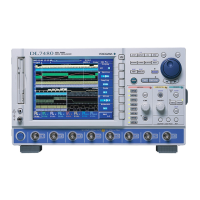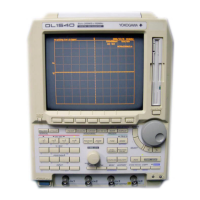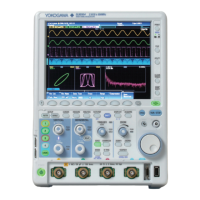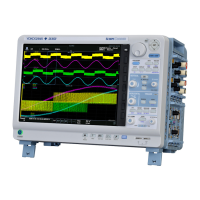6-10
IM DL850E-03EN
Item Specifications
Math source waveforms Analog channels 1 to 16 and the sub channels of scanner and CAN modules.
• Math results can be specified as sources of another channel.
• However, you can only specify math results of channels whose numbers are smaller
than the channel that you are specifying sources for.
Math delay A uniform delay for each math operation, regardless of the number of math channels
Mean The mean can be calculated on the math results.
Number of taps: 32 (fixed)
The calculation period changes automatically according to the DL850E/DL850EV
sample rate.
Zoom Method
Zooming by Setting a
Magnification
V Zoom is set in steps of 1, 2, or 5 to a value in the range of 10.00E–21 to 500.0E+18.
Zooming by Setting
Upper and Lower
Display Limits
Upper limit: ±5.0000E+22; lower limit: ±1.0000E–23
Power Math (Option)
Item Specifications
Math expression Real time math using hardware
Math source channels Analog channel 1 to channel 16 (multi-channel modules cannot be selected as math sources)*
Max. math rate 10 MS/s
Math data update rate 100 kS/s max.
Math result output channels Power analysis math CH13, CH14; harmonic analysis math CH15, CH16 (fixed)
Math result 16 bits (2400 LSB/div)
Results are converted to 16-bit values according to the scaling setting and stored in memory.
Power analysis
Max. number of analyzable
systems
Up to two three-phase systems can be computed simultaneously.
Max. number of simultaneous
math parameters
126 when one system is measured
54 × 2 systems when two systems are measured
Supported wiring systems Single-phase, two-wire (1P2W); single-phase, three-wire (1P3W); or three-phase, three-wire
(3P3W),
Three-phase, three wire system that uses a three-voltage, three-current method (3P3W;
3V3A); three-phase, four-wire system (3P4W)
Delta math function Three-phase, three-wire (3P3W) → three-phase, three wire system that uses a three-voltage,
three-current method (3P3W; 3V3A)
Three-phase, three-wire (3V3A) → three-phase, four-wire system (3P4W) (delta → star)
Three-phase, four-wire system (3P4W) → three-phase, three-wire (3V3A) (star → delta)
Math items Rms voltage and current of each phase
Voltage and current simple average of each phase (DC)
AC voltage and current components of each phase (AC)
Active power
Apparent power
Reactive power
Power factor
Current phase difference
Voltage and current frequencies
Maximum voltage and current, minimum voltage and current
Maximum power, minimum power
Integrated watt-hour, integrated watt-hour of each polarity (positive and negative)
Integrated ampere-hour, integrated ampere-hour of each polarity (positive and negative)
Apparent energy
Reactive energy
Impedance of the load circuit
Series resistance of the load circuit
Series reactance of the load circuit
Parallel resistance of the load circuit
Parallel reactance of the load circuit
Three-phase voltage unbalanced factor
Three-phase current unbalanced factor
Motor output math
Power efficiency (select motor output result and power math result or power math result of
two systems
6.5 Features
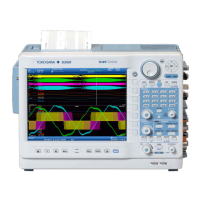
